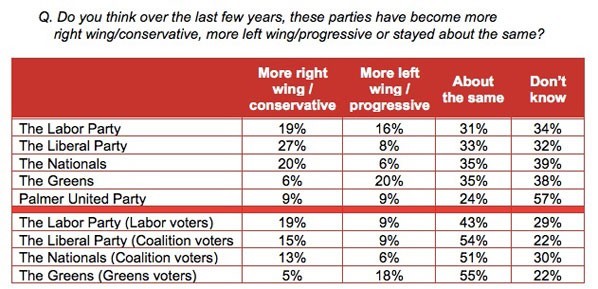Voters prefer Labor’s original national broadband network and remain gloomy about the overall direction of the economy, this week’s Essential poll shows.
Asked if they prefer the government’s cheaper, slower version of the NBN (the cost of which has recently blown out by several billion dollars) or Labor’s more expensive and faster version, 29% of voters prefer the government’s NBN while 38% prefer Labor’s NBN, with a third saying they don’t know. Partisanship heavily flavours responses, with 62% of Labor voters and 66% of Greens voters favouring Labor’s plan and 63% of Coalition voters preferring the government’s plan.
On voting intention, the Coalition is down a point to 40%; Labor and the Greens are both up a point to 38% and 11% respectively for a two-party preferred outcome of 52%-48% in favour of Labor, up from 51%-49% last week.
There’s better news for the Coalition on voter trust of parties’ handling of issues. The government has either increased its lead or narrowed its deficit against Labor across a range of attributes since February (admittedly a nadir for the Abbott government). It holds a strong lead, 40%-24%, as the party most trusted to handle the economy (compared to a 17-point lead in February). It trails Labor by just four points on education, compared to 10 points in February; it has extended its lead on controlling interest rates from 13 to 16 points; it has turned a narrow deficit (-2) on “ensuring a fair taxation system” into a four-point lead, and even narrowed its deficit on “a fair industrial relations system” from -10 to -8.
Against that, Labor holds strong leads over the Coalition on which party best represents the interests of various groups. For families with young children, students, people on average incomes and low incomes, people on welfare and pensioners, Labor holds double-digit leads over the Coalition, which leads Labor only on representing people on high incomes, small business and the self-employed, big business (it leads Labor 61% to 9%) and rural and regional Australians, though it only trails Labor by one point on representing the interests of indigenous people.
However, voters still remain gloomy about the economy. Forty one per cent of voters believe the economy is heading in the wrong direction, compared to 40% at budget time and 41% last August; 35% say it’s headed in the right direction, the same level as May and August 2014.
As usual, opposition-party voters are far more gloomy than government-party voters — indeed, almost perfectly opposite in their perspectives on the economy (just to demonstrate that effect, a month before the 2013 election, 66% of Labor voters thought the economy was heading in the right direction and 66% of Coalition voters thought it was heading in the wrong direction; two months later, 52% of Coalition voters believed it was headed in the right direction).
Essential also asked voters about whether they perceive political parties as too right-wing or left-wing. The response from voters about the parties they currently support was instructive. Labor voters thought their party was “about right” in 53% of response; 10% thought it was too far to the right and 8% thought it was too far to the left. Coalition voters gave the Liberals a higher “about right” score — 58% — and split 13%/6% on too right/too left. But Coalition voters (remembering they include both Liberals and Nationals voters) rated the Nationals too far to the right 18% of the time, and just 7% thought the country cousins were too left-wing. Greens voters have gave the highest “about right” score, 67%, but 17% also thought the Greens were too far to the left; only 2% thought they were too far to the right. For voters overall, 34% believed the Liberals were too far to the right, compared to 20% who thought Labor was too far to the left.
Asked a different question about whether parties had become more left-wing or right-wing in recent years, the results changed.
Nineteen per cent of Labor voters thought the party had become more right-wing in recent years, and just 9% thought it had become more left-wing; Coalition voters split 15%/9% on the Liberals, and 13%/6% on the Nationals. The Greens were perceived to have become more left-wing by 18%. The perception that the Liberals have shifted to the right was held by 27% of voters overall.










Bernard, it’s not about how far Parties have gone ideologically to the Left, Right, or anywhere else.
It’s about how far they’ve gone in the direction of their elites using their positions for personal ambitions, and how successfully they can fool both the Electorate and their own memberships.
Surely It’s Time you tackled this issue seriously?
We must be living among a population who think they are close relatives of Alice in Wonderland, if 40% of them see the Coalition handling the economy better than Labor at 24%!
Clearly many folk in that 40% do NOT understand economics, so why not join those in the “don’t know” column, rather than make a fool of yourself?
It should be apparent to anyone with half a brain, and just a smidgen of economic knowledge, that this LNP govt is trashing our economy on a daily basis.
They simply don’t have a clue!!
[It holds a strong lead, 40%-24%, as the party most trusted to handle the economy]
Unbelievable. It just goes to show how out of touch the average voter is. I’ve lost track of where the deficit is now.
Further to my comment @2, no need to go far.
[Australia’s debt has risen the most under this very government.]
http://uat.crikey.com.au/2015/09/01/australia%E2%80%99s-government-debt-look-over-there-bill-shorten/
$111.36 billion added to the debt in two years!
189% of Greens voters “Don’t Know” if we’re going in the right direction about the economy?
Is that someone’s joke using statistics? 🙂